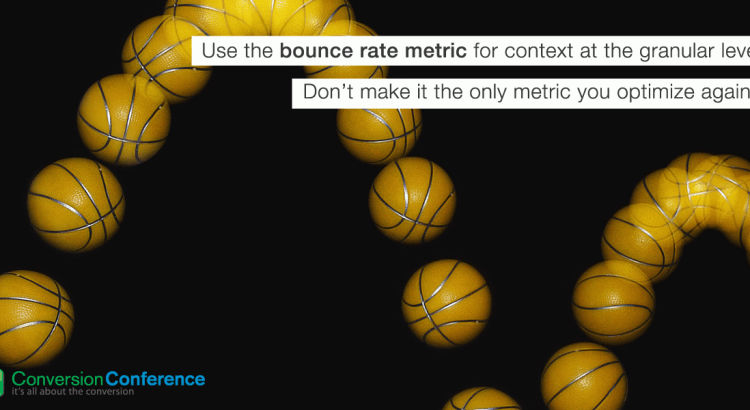I hear a lot of varying opinions on the bounce rate metric in analytics. Some think the overall bounce rate is a key metric in site performance and others think it is completely worthless. I’ve gone back and forth over the years and ended up landing in the middle, believing that both sides are wrong and right.
Why Overall Bounce Rate Is Dangerous
The overall bounce rate is good to get a quick read on how people are engaging with your site, but it is an average of all pages and that is precisely why you can’t rely on it as a KPI.
Simply watching the overall bounce rate will only show you incremental change. The more pages on your site, the less your bounce rate will change if a small group of pages spike from 40% to 90%. You aren’t going to jump in to find problems if you see your bounce rate go from 43.12% to 43.19%, but this may result in several revenue-driving pages performing poorly.
Even if you do want to dramatically improve your overall bounce rate, the way you will do that is by drilling down into your landing pages to find areas for improvement. So, get into the details and don’t live or die by the average.
Why Ignoring Bounce Rate Is Dangerous
While the overall bounce rate doesn’t give context, it is crucial to be tracking bounce rate for specific landing pages & campaigns. If you are spending money on traffic, you should understand how much is bouncing. Changes in keywords, targeting and ad content can change the experience for that visitor and the bounce rate for each landing page is an excellent signal for understanding if the change was positive or negative.
Outside of paid traffic, there are still going to be a lot of pages on your site that will be driving leads/revenue organically. If your bounce rate goes up on these pages, it is likely that your conversion rate will go down and leave you with less money at the end of your funnel.
I would recommend identifying your top revenue generating pages and creating a custom dashboard that shows stats for those pages so that you can use bounce rate as a signal of possible performance issues. The pages driving the most value for your site should be viewed frequently and easily accessible.
How to Approach Single Page Sites
If you have a single page website or an orphan landing page, it may appear that your bounce rate is incredibly high. Unless your page is strictly informational, there will likely be one or more actions you want the visitors to take.
If you add Event Tracking to any of the buttons, links or videos on that page, Google Analytics will count those actions as an interaction. This will prevent anyone with an interaction from appearing as a bounce and help you understand how each channel is truly performing.
The Only Way to Use Bounce Rate
Use the bounce rate metric for context at the granular level. Don’t use averages and don’t make it the only metric you optimize against. Let it signal what visitors are expecting to see/do on the page and align your messaging to meet that expectation.
Ready for More Conversion-Boosting Tips?
Join the worldwide community of conversion optimizers at ConvCon 2017!
This post originally appeared on NPTurner.com
About the Author
 Nate Turner is currently the Online Marketing Director for Sprout Social, a social media management platform, where he is responsible for customer acquisition, marketing strategy, online marketing campaigns, optimization and analytics. He is an experienced digital marketing specialist with a passion for new media and startups.
Nate Turner is currently the Online Marketing Director for Sprout Social, a social media management platform, where he is responsible for customer acquisition, marketing strategy, online marketing campaigns, optimization and analytics. He is an experienced digital marketing specialist with a passion for new media and startups.

 717 798 3495
717 798 3495




When looking at the bounce rate for a particular landing page it is also useful to break it down by traffic source – you may find, for example, that the bounce rate for Paid Search on a given page is low and healthy while the bounce rate for Paid Display is high (and even higher than average for that source). This may indicate an opportunity to optimize your Display campaign as opposed to the page itself. This could also help make a case for targeting and personalization on the landing page according to the visitor’s attributes (which includes the traffic source).
When looking at the bounce rate for a particular landing page it is also useful to break it down by traffic source – you may find, for example, that the bounce rate for Paid Search on a given page is low and healthy while the bounce rate for Paid Display is high (and even higher than average for that source). This may indicate an opportunity to optimize your Display campaign as opposed to the page itself. This could also help make a case for targeting and personalization on the landing page according to the visitor’s attributes (which includes the traffic source).
Yes, only use bounce rate at a granular level. We use it for differences in devices to see if new responsive site works. Equally for single site pages but only as a guide. Certainly won’t use it to set targets.
Yes, only use bounce rate at a granular level. We use it for differences in devices to see if new responsive site works. Equally for single site pages but only as a guide. Certainly won’t use it to set targets.